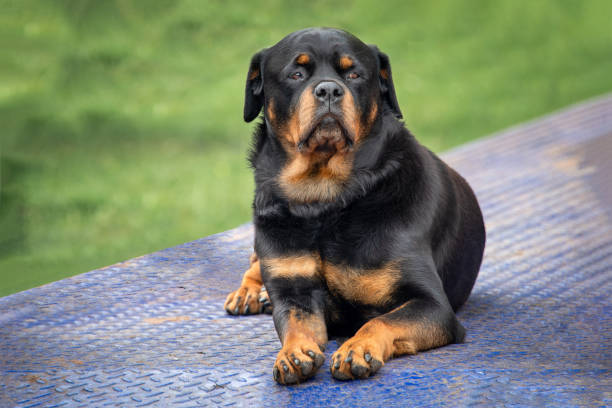Table of Contents
Introduction
The Rottweiler is a powerhouse of a dog, boasting a robust build and a confident demeanor that really catches the eye. Wherever it goes, it turns heads. But don’t let that tough exterior fool you; this breed is incredibly loyal to its family. They’re smart enough to tackle complex tasks and show a lot of love when they’re properly socialized. Unfortunately, Rottweilers often get a bad rap and are misunderstood. They truly deserve a more compassionate perspective.
If you’re considering adding a dog to your family, have a soft spot for this breed, or are simply curious, stick around. You’re about to discover one of the most devoted companions you could ever find!

Origins and History of the Rottweiler
The Rottweiler has a fascinating history that dates all the way back to Ancient Rome. Roman soldiers brought along mastiff-type dogs, which were essential for herding and guarding cattle. These dogs were known for their strength, adaptability, and bravery—qualities that the Rottweiler still embodies today.
As the Roman Empire crumbled, the breed found new purpose in Rottweil, Germany. There, butchers relied on them to herd livestock and haul carts loaded with meat and goods. They affectionately earned the nickname “Rottweiler Metzgerhund,” which means Rottweil butcher’s dogs. This rich history helped shape their reputation as a breed that combines intelligence with physical strength.
In the 19th century, Rottweilers became less common due to the rise of mechanized transport. However, dedicated enthusiasts worked to revive the breed, showcasing its versatility. The American Kennel Club (AKC) officially recognized the Rottweiler in 1931, and since then, it has become a beloved choice for families, law enforcement, and service roles.
Physical Characteristics
Rottweilers are strong, medium-to-large dogs that really embody strength and confidence. They’re athletic, solidly built, and well-balanced, which means they can burst into action with impressive speed when the moment calls for it.
Key Traits:
Height: 22–27 inches (56–69 cm)
Weight: 80–135 pounds (36–61 kg)
Build: Muscular and compact
Coat: Short, double-layered, and dense
Color: Always black with distinct rust, tan, or mahogany markings
These dogs have a broad head with a gently rounded forehead and a strong, square muzzle. Their dark eyes reflect a deep intelligence, and their ears are positioned close to their head, giving them an alert and focused appearance.
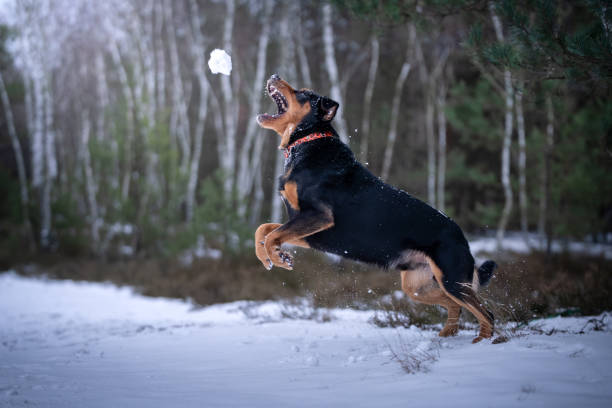
Temperament and Personality
Rottweilers might have a tough exterior, but underneath, they’re incredibly loving, loyal, and calm companions. They really thrive in a stable home environment, forming strong bonds with their families and often following their humans from room to room.
Key Temperamental Traits:
– Loyal and protective
– Confident yet calm
– Cautious around strangers
– Affectionate with their loved ones
– Eager to work and learn
A well-socialized Rottweiler isn’t aggressive by nature; they’re natural guardians. If they sense any danger, they’ll step up to protect their family. Their loyalty and intelligence make them ideal for roles that require focus and discipline.
Rottweiler Intelligence and Trainability
- Rottweilers are incredibly smart and eager to please. They really shine when they have a structured training routine, plenty of mental challenges, and tasks to keep them engaged. These dogs excel in obedience training, agility, and even advanced protection work. With clear guidance, they can truly thrive.
- According to Dr. Stanley Coren’s rankings, Rottweilers are listed among the top 10 smartest dog breeds. They pick up commands quickly—often after just a few repetitions—and they remember them well.
- Training Tips:
- Start obedience training early (around 8–10 weeks old)
- Use positive reinforcement techniques
- Be consistent and firm, but avoid being harsh
- Keep things interesting—mix up commands, games, and training styles to prevent boredom
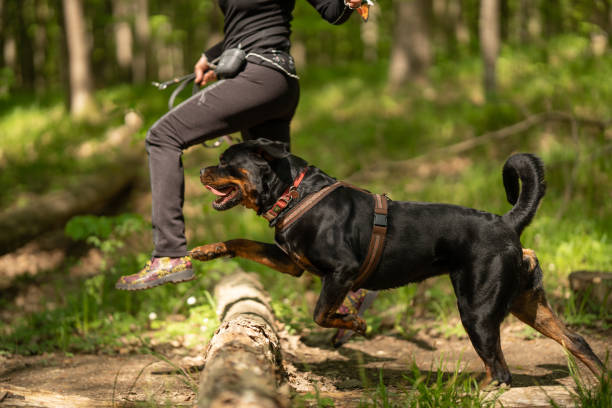
Socialization Needs
Getting your Rottweiler socialized early on is super important. It sets them up to be a well-rounded adult. By introducing puppies to a variety of people, kids, other pets, traffic, different sounds, and new environments, you help them stay relaxed. This way, they’re less likely to feel anxious or act aggressively.
Key Areas to Focus On:
– Interactions with other dogs and pets
– Meeting new people and children
– Navigating crowds and busy areas
– Visiting the vet and going through grooming sessions
If Rottweilers don’t get enough socialization, they might become overly protective, shy, or reactive. A Rottweiler that hasn’t been socialized properly is more prone to misreading harmless situations as threats.
Living With a Rottweiler: Home Environment
Rottweilers are pretty adaptable and can thrive in various living situations, including apartments, as long as they get enough exercise. While they tend to be calm indoors, they do need mental and physical stimulation to keep boredom and destructive habits at bay.
They really flourish in:
– Homes with a secure yard, ideally fenced in
– Active families who enjoy engaging them in physical activities
– Households that prioritize training and socialization
However, their size and strength can pose challenges for delicate homes or older owners. It’s all manageable, though, as long as they’re well-trained and maintain a calm demeanor.

Rottweiler Exercise Requirements
- Rottweilers are powerful and energetic dogs that thrive on regular exercise to keep them healthy and content.
- Daily Exercise:
- 1.5–2 hours of physical activity
- Enjoying long walks or jogs
- Having playtime in secure, fenced areas
- Engaging in structured games like fetch, tug-of-war, or using puzzle toys
These dogs also shine in various dog sports, such as:
- Agility
- Tracking
- Schutzhund (a protection sport)
- Cart pulling
- Obedience competitions
Diet and Nutrition Guidelines
When it comes to keeping your Rottweiler happy and healthy, a well-balanced diet is key. These dogs thrive on a nutritious meal plan that’s packed with protein and tailored to their size and activity level.
Here are some nutrition tips to keep in mind:
– Protein: Aim for at least 22–26% (meat-based is the best choice)
– Fats: Keep it moderate for energy
– Calcium: Crucial for strong bones
– Omega-3: Great for maintaining a shiny coat and healthy joints
You can feed them high-quality kibble or opt for raw or home-cooked meals, but make sure to do this under your vet’s guidance. Also, be mindful of portion sizes to prevent obesity, as Rottweilers can easily gain weight due to their large build and hearty appetites.

Grooming and Coat Care
The Rottweiler sports a short double coat that’s pretty low-maintenance. That said, they do shed quite a bit, especially during the spring and fall seasons.
Grooming Checklist:
Brushing: 1–2 times a week
Bathing: Every 4–8 weeks
Nail trimming: Monthly
Ear cleaning: Weekly to keep infections at bay
Dental care: Brush their teeth 2–3 times a week
Despite their tough appearance, Rottweilers actually enjoy grooming sessions. They really appreciate the attention it brings!
Common Health Issues in Rottweilers
When it comes to purebred dogs, Rottweilers are no exception—they can be prone to certain health issues due to their genetics.
Here are some common health concerns to keep in mind:
– Hip and elbow dysplasia
– Aortic stenosis
– Osteosarcoma (bone cancer)
– Progressive retinal atrophy (PRA)
– Hypothyroidism
– Bloat (gastric torsion)
It’s important to choose responsible breeders who test for these conditions. Always make sure to ask for health clearances before you adopt or buy a Rottweiler.
Lifespan and Aging
When it comes to Rottweilers, their average lifespan ranges from 8 to 10 years, but with the right care, many can live even longer. Interestingly, female Rottweilers tend to outlive their male counterparts by a bit.
As they grow older, you might notice a few changes:
– They could benefit from joint supplements
– Their metabolism starts to slow down
– They may need some cognitive support, like mental stimulation and interactive toys
Senior Rottweilers are incredibly loyal and protective. In fact, they often show a gentler and more patient side, especially around children, compared to their younger days.
Rottweiler Puppies: What to Expect
Rottweiler puppies are absolutely adorable, but they can also be quite a handful. These little furballs are curious, strong-willed, and eager to learn — plus, they grow at an impressive rate!
Key Development Phases:
8–12 weeks: This is the time for socialization and learning basic commands.
3–6 months: Expect some teething and a bit of boundary testing during this phase.
6–12 months: Welcome to adolescence, where you might see some assertive behaviors.
It’s crucial to start training early. Incorporate crate training, teach leash manners, and use positive reinforcement to help establish your leadership.
Training Tips for First-Time Owners
If you’re a first-time Rottweiler owner, here are some helpful tips to get you started:
Think about signing up for professional obedience classes.
Take the time to learn about canine body language; it can really help you understand your pup better.
Steer clear of any harsh training methods; they don’t work well with these dogs.
Remember to be patient—consistency is really important.
Rottweilers thrive with owners who are calm, assertive, and loving, but it’s crucial not to be overly soft with them.
Are Rottweilers Good Family Dogs?
Absolutely! Rottweilers can be fantastic family dogs when they’re raised right. They tend to form deep connections with their families and often get particularly close to one or two family members.
These dogs are naturally protective of children, but it’s important to keep an eye on them, especially around little ones, due to their size.
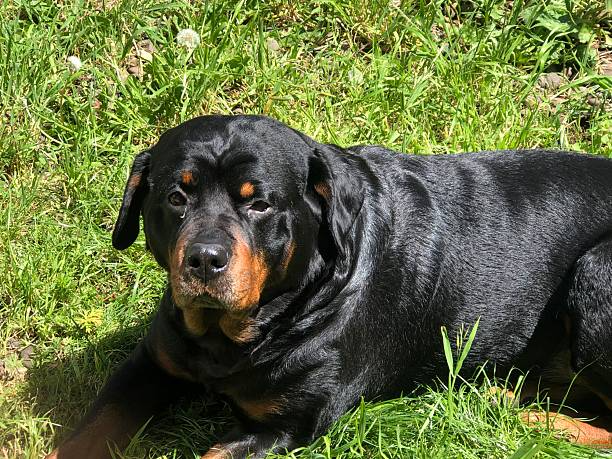
Rottweilers With Children and Other Pets
Rottweilers and Their Compatibility with Kids and Other Pets
With the right early exposure and training, Rottweilers can get along quite well with:
Kids: They tend to be gentle, tolerant, and protective.
Cats: They can coexist peacefully if they’re raised together from a young age.
Other dogs: Be mindful that same-sex aggression can happen, so socialization is really important.
However, they might not be the best fit for homes with lots of pets. Starting their training early and introducing them properly can make a big difference.
Legal Considerations and Breed Restrictions
In some areas, Rottweilers face bans or restrictions, largely because of their powerful reputation. It’s always a good idea to check:
– Local breed-specific legislation (BSL)
– HOA or apartment rules
– Homeowners or renters insurance policies
Despite the unfair stigma, many communities do welcome Rottweilers, especially when their owners are responsible and proactive.
Rottweiler as Working Dogs: Police, Guarding & Service
Rottweilers have earned a solid reputation for their incredible versatility in various work roles, including:
– Police and military duties
– Search and rescue operations
– Guarding and protection tasks
– Service and therapy assistance
– Livestock herding
These dogs truly shine when they develop a strong bond with their handler. Their obedience, loyalty, and bravery make them some of the best working dogs out there.
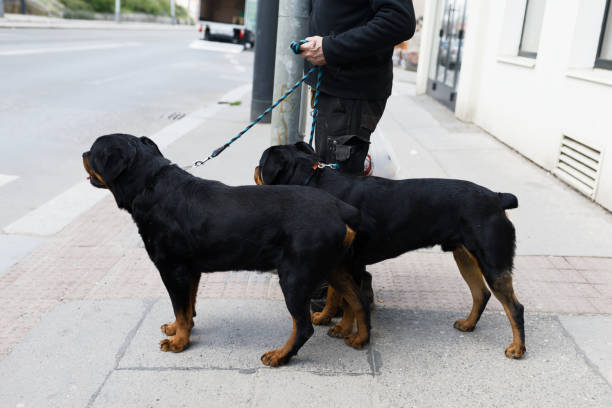
Ethical Breeding and Adoption Tips
If you’re thinking about adopting or buying a Rottweiler, here are some helpful tips to keep in mind:
– Look for reputable breeders who prioritize health testing.
– Consider visiting local shelters, as many Rotties are surrendered because of their size or energy levels.
– Always ask for important documents, like lineage and veterinary records.
– Steer clear of backyard breeders and puppy mills.
Remember, adopting a Rottweiler can be a wonderful way to give a deserving dog a fresh start!

Pros and Cons of Owning a Rottweiler
Pros:
- Deeply loyal and affectionate
- Highly trainable and intelligent
- Protective of family and home
- Great working or guard dog
Cons:
- Needs early and continuous training
- May be wary or aloof with strangers
- Strong prey and guarding instincts
- Not ideal for timid or passive owners
Fun Facts About Rottweilers
- The Rottweiler is one of the oldest herding breeds.
- They were among the first guide dogs for the blind.
- Their bite force is estimated at over 300 PSI.
- In Germany, they must pass a temperament test to be bred.
- Rottweilers starred in several films, including The Omen (though unfairly portrayed as villains).
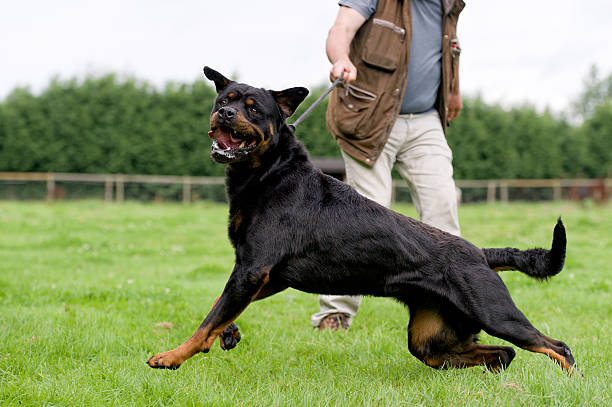
Final Thoughts
The Rottweiler is so much more than just a tough guard dog; it’s a loyal companion and an incredibly intelligent friend. This breed has been serving alongside humans with honor for centuries. With the right training, socialization, and care, a Rottweiler can truly become a devoted friend.
If you’re ready to take on the responsibility, a Rottweiler could be the perfect fit for you. This breed is not only a steadfast protector but also has a gentle side. By providing structure, love, and attention, you’ll create a strong and lasting bond.

